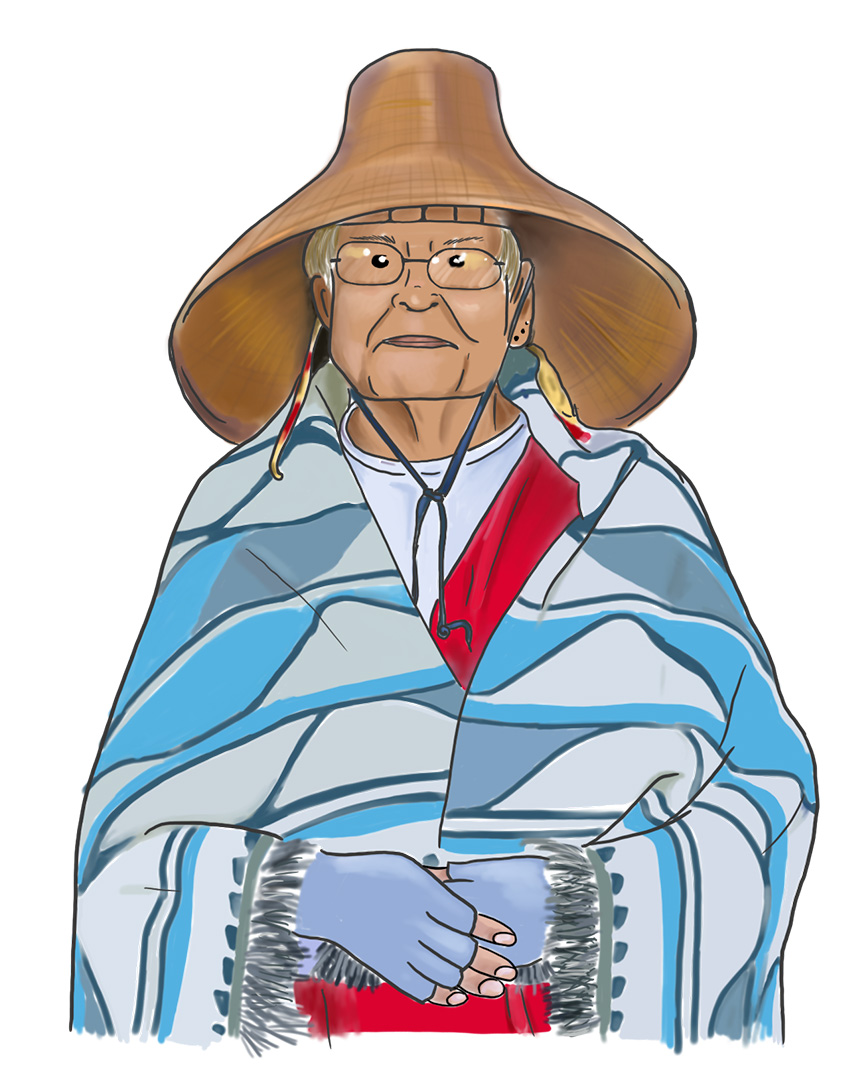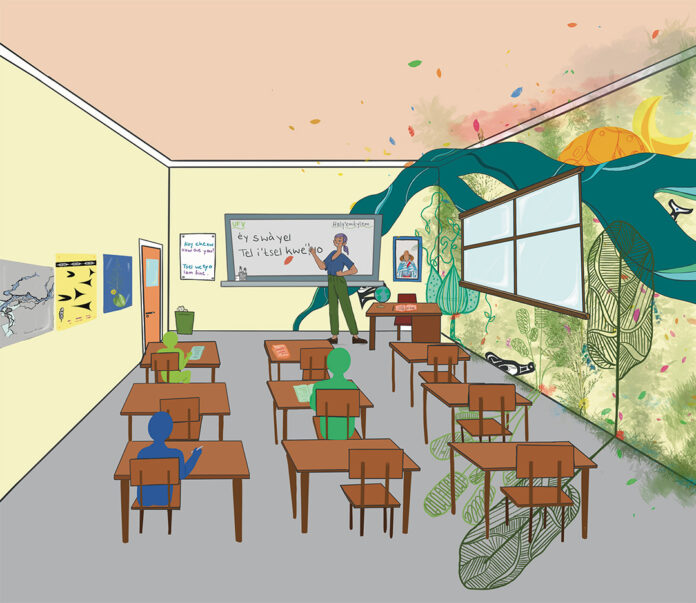This fall, a new graduate certificate is being offered at UFV with a cohort of students already enrolled who hope to revitalize the endangered Indigenous language of upriver Halq’eméylem, originally spoken by members of the Stò:lo nation. The Halq’eméylem graduate certificate will help to improve students’ proficiency in the language and prepare them for their future careers and roles as language revivalists, teachers, and specialists. As Ghizlane Laghzaoui, associate professor in UFV’s modern languages department and Chair of the Halq’eméylem Program Working Group explains, the program will provide students with opportunities to “incorporate, promote, and sustain the Halq’eméylem language in their everyday lives.”
The objectives of the Halq’emeylem graduate certificate program
“The graduate certificate will add on to what’s available in the sense that now students are able to go beyond learning and then go to teaching the language,” said Mary Stewart, an assistant professor in Halq’eméylem who has been teaching the language for the past 22 years.
There are currently six undergraduate Halq’eméylem courses offered at UFV that are designed to develop students’ pronunciation, vocabulary, and grammar. This graduate certificate is intended to produce teachers that will ensure this language gets passed along to the next generation.
“This program responds to an emergency: the survival of Halq’eméylem, this is the main importance,” said Laghzaoui. “It is putting back a missing piece in the university’s priorities and mandate.”
Laghzaoui hopes that the program will “bring more awareness and action around the close ties between language, land, and culture and how their survivals are codependent.”

Halq’emeylem history and its last fluent speaker
Siyamiyateliyout, also known as Elizabeth Phillips, is the last fluent speaker of Halq’eméylem alive today. She held onto this precious language by having imaginary conversations in her head with her parents while attending St. Mary’s residential school in Mission from 1947 to 1954, a setting where children were punished for speaking their mother tongue. Phillips dedicated her life to Halq’eméylem preservation and translation as she learned how to write down what was traditionally an oral language in hopes that this knowledge would not be lost.
There are three principal dialects of Halq’eméylem: upriver, downriver, and island. This certificate (along with all UFV Halq’eméylem courses) cover the upriver dialect, whose native speakers can be found predominantly in Chilliwack, Chehalis, Sumas, and the surrounding areas.
The Coqualeetza Cultural Education Centre, incorporated as a non-profit in 1973, serves the Sto:lo people by offering culturally relevant programs and services that enhance self-esteem and pride, such as Halq’eméylem instruction, curriculum development, and historical archives. In 1977, this cultural center was the site where the oral language of Halq’eméylem was first alphabetized into a written language with the help of linguist Brent Galloway and the Coqualeetza Elders Group. First Voices has made this invaluable resource available for all who want to learn Halq’eméylem through their word dictionary, phrase dictionary, and alphabet.
“The loss that we see in language across Canada and in this territory is not only the loss in language,” Christine Seymour, Fraser Cascade’s Indigenous education principal, told the Fraser Valley Current. “It’s not just a reflection of loss of language. It’s reflected in the loss of culture as well. So Indigenous people right now are working really hard to get back on our feet, but also to recover those important things that we’ve lost throughout over 100 years of the residential school system in Canada.”
Challenges in language revitalization
A 2013 study identified some challenges of Halq’eméylem language revitalization, including: lack of fluent speakers in the community, scarcity of curriculum available for teaching younger students, and a shortage of government-certified teachers competent in the language. This graduate certificate program will attempt to tackle some of these challenges head on.
Stewart, who has been involved in language revitalization since 1994 and has taught at UFV since 2013, observed that over the past five years there has been a resurgence of people who are interested in learning the language. Stewart, along with her colleagues, were motivated to create this graduate certificate to “prepare for the future” and produce more teachers to replace those who are nearing retirement age and fill the void of qualified teachers who are able to instruct classrooms in Halq’eméylem.
Stewart recognized that learning this language was not solely for knowledge requisition, but said that students found it healing and empowering to learn this endangered language, especially for those students who attended, or whose parents or other relatives attended residential schools, where the speaking of Indigenous languages was forbidden.
“It’s more than learning the language,” said Stewart, “it’s part of them.”
“Indigenous languages embody and express ancient knowledge of environment and social relations, and thus deeply connect students to the way of thinking and being of their ancestors,” said Marianne Ignace, director of Simon Fraser University’s First Nations Languages Centre.
Stewart reflected that the main barrier to language revitalization was the lack of curriculum and materials to teach students. “The big challenge of instructors is the lack of resources. I can’t go out and buy a curriculum … It’s always an ongoing process of developing curriculum, that’s our goal. The idea that one day, we can have [materials] available.”
The many reasons to learn Halq’emeylem
Sophia Moreno belongs to the first cohort of students enrolled in this graduate certificate. Her goal in learning this language is to be able to teach Halq’eméylem to elementary students as well as elders who lost their grasp of this language while in residential school.
“We don’t want the language to leave,” said Moreno, whose objective is to ensure there will always be fluent speakers of the language.
“Keep in mind that you will not be the last to learn and speak Halq’eméylem,” said Laghzaoui, when asked what advice she would give to students enrolled in this program. “Put all your passion and motivation into it, never give up, never concede, and be part of the restoration of Halq’eméylem language.”
UFV currently supports the annual, community based Halq’eméylem Translation Contest, a day where Indigenous youth are given the opportunity to demonstrate their skills in endangered languages and further expand their vocabulary. The availability of Indigenous language programs across the Fraser Valley region varies, as some students have access to full university-level courses, and others may only participate in just this one workshop every year. This signals a need to train more language teachers so that students have the opportunity to learn the language spoken by their ancestors.
A 2009 study found that children who were learning Halq’eméylem as young as age three, in programs like the Aboriginal Head Start program and Seabird Island’s Language Nest, were able to pronounce the difficult throaty words in the language, and children often came home using the language, which sparked interest in their parents.
“This stands as an interesting example of how language initiated in the preschools may have a repairing effect on a lost generation of language users,” wrote researcher Margaret MacDonald.
UFV’s graduate certificate will create a new generation of teachers that will continue to pass on this knowledge to their students. This graduate certificate is the first step to creating Halq’emeylem immersion schools and no longer having to speak in terms of survival when talking about this language.
“I understood being Stó:lo,” said Dianna Kay, Halq’emeylem instructor with UFV, “but I never really understood being Stó:lo until I started [learning] the language, and things just made sense.”
Learn some Halq’eméylem phrases:
éy swáyel . . . . . Good day
… tel skwi:x . . . . . My name is …
chexw tel e’letse? . . . . . Where are you from?
Tel i’tsel kwe’lo . . . . .I am from here
Tèlí tsel kw’e . . . . . I am from …
A’a . . . . . Yes
Ewe . . . . . No
>Hoy chexw . . . . . Thank you
Lí chexw we ey o? . . . . . How are you?
Tsel we ey o . . . . . I am fine
Andrea Sadowski is working towards her BA in Global Development Studies, with a minor in anthropology and Mennonite studies. When she's not sitting in front of her computer, Andrea enjoys climbing mountains, sleeping outside, cooking delicious plant-based food, talking to animals, and dismantling the patriarchy.


